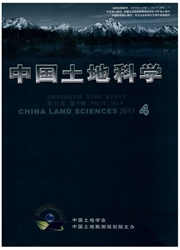

 中文摘要:
中文摘要:
研究目的:评价耕地质量占补平衡实施效果,为完善耕地占补平衡机制提供建议。研究方法:统计分析方法。研究结果:研究区域2011—2013年建设占用与补充耕地质量基本持平,建设占用水田面积小于补充水田面积;不同类型区的建设占用和补充耕地质量、占水田补水田能力均存在较大差异;建设占用与补充耕地质量和地均GDP都存在较高的相关性,与年度GDP相关性不显著。研究结论:研究区域基本实现耕地质量占补平衡,严格执行以补定占,科学选址,控制建设占用耕地和补充耕地质量在可实现范畴;可通过补改结合、异地占补等多样途径落实占水田补水田要求;盘活存量,控制和优化增量,继续提升土地集约节约水平,减压占补平衡同时,改善耕地质量占补平衡效果。
 英文摘要:
英文摘要:
The purpose of the paper is to evaluate the effect on farmland quality dynamic balance and to propose some measures for improving the balance of arable land mechanism. The statistic analysis is used to calculate the dynamic relationships among all variables. The result shows that the quality of the occupation cropland and supplement cropland is almost identical. Supplementary paddy field area is larger than the area occupied by paddy fields. There are differences between different types of the area. There is a higher correlation between occupation cropland and supplement cropland. It reveals that the farmland quality dynamic balance is basically finished in the region. The research region obeys the rule of occupying farmland in accordance with offsetting arable land, and the rule of selecting offset areas scientifically while controlling the quality of occupied and offset arable land within the achievable extent. We can apply various measures to achieve paddy fields balance, such as combing complement and improvement, off-site complement and so on. Moreover, we should redevelop stocking land, control and improve farmland conversion, continue to increase the level of land intensive and saving usage, in order to relieve the pressure from farmland quality dynamic balance and improve its performance.
 同期刊论文项目
同期刊论文项目
 同项目期刊论文
同项目期刊论文
 期刊信息
期刊信息
